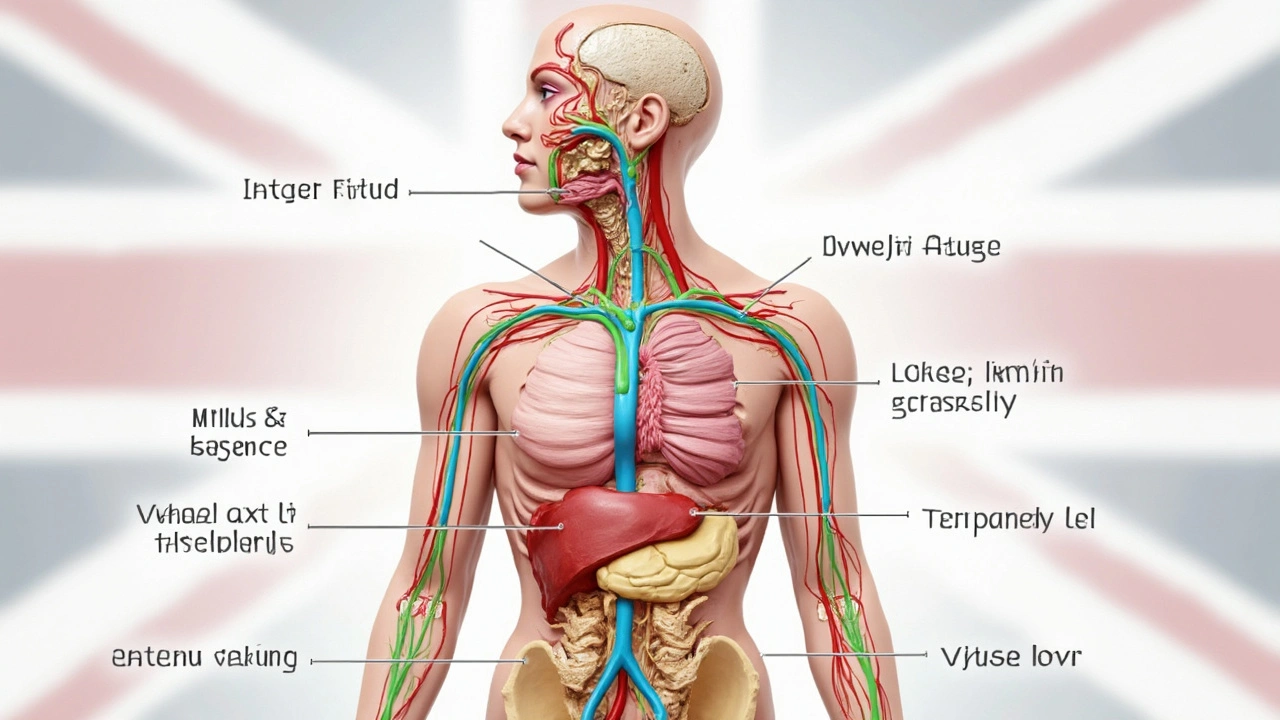If you’ve ever searched for ways to beat swelling, detox, or just feel a little lighter, you’ve probably seen people rave about lymphatic drainage massage online. But what’s really going on when someone glides their hands gently across your skin? Is it legit, or just another wellness trend?
This kind of massage doesn’t feel like a deep tissue session. Instead, it uses gentle, rhythmic movements that help move fluid through your lymphatic system. It sounds simple, but it has a real purpose—helping your body get rid of waste and feel less puffy.
People come in for these massages for all sorts of reasons: recovering from surgery, fighting leg swelling after a long flight, or even just looking for that healthy glow before an event. If you've ever noticed your ankles swelling or felt sluggish, there’s a good chance your lymphatic system could use a little help. Here’s what you need to know before booking your first session.
- What Is Lymphatic Drainage Massage?
- How the Lymphatic System Works
- Benefits You Can Actually Feel
- Tips for Getting the Most Out of Your Session
- How to Choose the Right Therapist
What Is Lymphatic Drainage Massage?
Lymphatic drainage massage might sound like a mouthful, but it’s actually pretty straightforward. It’s a type of bodywork that helps your lymphatic system move fluid throughout the body, which your immune system relies on to filter out toxins and waste. This style of massage was first developed by Danish doctors Emil and Estrid Vodder in the 1930s and has gained trust among medical professionals ever since.
The main technique uses light, slow, and repetitive strokes—much softer than the pressure in sports or deep tissue massage. The goal is to nudge lymph fluid toward lymph nodes, where it gets cleaned and any unwanted stuff is flushed out. A pro therapist follows the direction of lymph flow, usually working from the limbs toward the heart.
"Manual lymphatic drainage is a specialized, gentle massage technique that encourages the natural movement of lymph fluids and plays a key role in managing swelling and supporting immune health." — Cleveland Clinic
Sessions can last anywhere from half an hour to a full hour, and you’ll usually lie on a massage table, dressed in comfortable clothes or wearing underwear. Don’t expect oils or deep knuckle work here; it’s all about gentle movement and rhythm. Some sessions might also include tips on how you can boost your results at home, like using dry brushing or simple exercise.
The most important thing to remember: always get this type of massage from someone trained in lymphatic work—and let your therapist know about any health stuff or recent surgeries. If you see the word lymphatic drainage massage at a spa or clinic, check their credentials before booking.
How the Lymphatic System Works
Your body doesn’t just rely on blood to stay balanced and healthy. There’s another network that often gets overlooked: the lymphatic system. It’s like your body’s cleaning crew—moving excess fluid, toxins, and waste out and helping keep your immune system strong.
This system runs all over, using hundreds of little nodes (think of them as filter stations) and a web of vessels. Unlike your blood, your lymph fluid doesn’t have a heart to pump it around. Instead, it depends on regular movement—things like walking, breathing, and yes, massage—to keep things flowing.
Here’s what matters most: when your lymph system gets sluggish, you might notice puffiness, swelling, or even get sick more easily. After surgeries or injuries, things can really slow down and fluid can pool up, making you feel downright uncomfortable.
According to Johns Hopkins Medicine,
"The lymphatic system is an essential part of immunity, as it helps the body remove toxins, waste, and other unwanted materials. A healthy lymph system is vital for maintaining overall health."
Signs your lymph system isn’t running smoothly? Swelling in hands or feet (called lymphedema), slow healing, or even a heavy, tired feeling. That’s where gentle support like lymphatic drainage massage steps in to help clear the backlog and get things moving again.
- The lymphatic system runs parallel to blood vessels but moves lymph, not blood.
- Lymph nodes are mostly in the neck, armpits, and groin—massage often targets these areas.
- Too little movement (think lots of sitting) makes lymph slow down, so staying active helps keep it healthy.
Understanding this system makes it clear: small changes can have a huge impact on how you feel day-to-day. And that’s what makes supporting your lymph flow so powerful.

Benefits You Can Actually Feel
The hype around lymphatic drainage massage starts to make sense when you see its direct effects. People often notice feeling lighter and less bloated after just one session. If you struggle with swollen legs, ankles, or face, that’s because excess lymph fluid can build up in your tissues. This massage style encourages your body to move that fluid out, which makes you look and feel less puffy.
Doctors sometimes suggest it for folks recovering from surgery or fighting conditions like lymphedema, which is basically long-term swelling. Research shows that targeted lymphatic massages can cut down swelling and speed up healing time. One small study from 2022 found that patients with leg swelling after knee surgery saw their swelling drop by around 36% after a few sessions.
It’s not just for medical needs, though. Athletes use these massages to bounce back quicker after tough workouts. People who sit a lot, like office workers or jet-setters, often book them to reduce that heavy, tired feeling in their limbs. And yes, there’s a reason influencers say their faces feel sculpted and glowy afterward—moving that trapped fluid can smooth out puffiness, at least for a day or two.
| Benefit | What You Notice | When to Expect It |
|---|---|---|
| Less swelling | Reduced puffiness in face, legs, or arms | Within hours to 2 days |
| Faster recovery | Less soreness after activity or surgery | After a few sessions |
| Relaxation boost | More calm, less tension | Right after the massage |
| Immune support | Fewer colds, easier fighting minor bugs | With regular sessions |
Not every benefit is instant or guaranteed, but plenty of people swear they feel a difference. If you’re looking for a natural nudge to your body’s own processes, this massage could be an easy win. Just don’t expect miracles. The biggest shifts happen with consistency and when you pair sessions with movement, water, and healthy meals.
Tips for Getting the Most Out of Your Session
To really cash in on the effects of lymphatic drainage massage, there are a few smart moves you should make before and after your appointment. Most people don’t realize just how much what you do outside the treatment room matters.
First up, get hydrated. Drink a couple of glasses of water before your session—your lymphatic system relies on fluids to move waste out of your body. If you’re dehydrated, those gentle massage moves won’t work as well. It also helps to drink water after the massage, too, to keep things flowing.
Wear something loose and comfy. Tight clothes can mess with circulation, which is the exact thing you’re trying to improve. Skip the jeans or leggings and go for sweatpants, gym shorts, or a relaxed dress.
If you have a big meal right before your appointment, you might feel sluggish. Eat light in the few hours leading up to your massage—nothing heavy or greasy that will leave you feeling stuffed and uncomfortable.
During the session, speak up if you feel uncomfortable. Lymphatic drainage massage should never feel painful—if it does, the therapist needs to adjust their pressure. Don’t be shy about asking questions, either. A good therapist will explain what they’re doing and why.
- Hydrate before and after your massage (aim for at least 16 oz).
- Arrive in loose, comfortable clothing.
- Eat light beforehand to avoid discomfort.
- Use the restroom before your session starts; frequent bathroom breaks afterward are totally normal due to increased fluid movement.
- Plan to take it easy after your massage. If you can, avoid strenuous workouts or alcohol for the rest of the day.
And here’s a quirky but true fact: most folks need to pee right after these sessions. It’s totally normal and actually a good sign that your body is flushing out extra fluids just like it’s supposed to.

How to Choose the Right Therapist
Picking someone for a lymphatic drainage massage isn’t just about searching “massage near me” and going with the top result. There’s a huge difference between someone who’s qualified and someone winging it. When the lymphatic system’s involved, you want someone who knows their stuff.
First, check for training. Look for therapists certified in lymphatic drainage—not just general massage. In the U.S., for example, therapists should have a license plus extra training. They may follow methods like the Vodder, Földi, or Casley-Smith techniques, which are real, science-backed approaches. Ask where they trained—don’t be shy! A reputable therapist will be happy to talk about this.
Experience counts especially if you have health conditions, recent surgeries, or a medical diagnosis that calls for careful handling. Ask how many lymphatic sessions they’ve done and if they’ve worked with someone who has your needs. Good therapists listen first and never push you to ignore medical advice.
Red flags? If a therapist can’t explain how the treatment works or promises “miracle detox” after one session, reconsider. Be wary if they dismiss your doctor’s advice or offer generic massages billed as lymphatic drainage. The right therapist will check for swelling, infections, or issues that could make massage risky, and might even recommend a doctor if you have red-flag symptoms.
Here are some quick steps to help you choose wisely:
- Check their certification from a recognized body (like the Lymphology Association of North America if you’re in the States).
- Ask about their specific training in lymphatic drainage massage, not just Swedish or deep tissue.
- Read reviews that mention actual lymphatic results, not just general relaxation.
- Look for clear hygiene practices—they should always wash hands, use clean linens, and avoid open wounds.
- Make sure they ask you about your health, medications, and goals before they start.
Pricing and session lengths can vary a lot. Here’s a rough idea:
| Location | Average Session Cost | Typical Duration |
|---|---|---|
| USA (urban) | $90-$150 | 60-90 minutes |
| UK | £50-£90 | 45-60 minutes |
| Australia | $90-$130 AUD | 60 minutes |
Remember, you’re putting your health in someone else’s hands—literally. Do a little homework first. You’ll get more out of the treatment and feel way more confident during your session.
